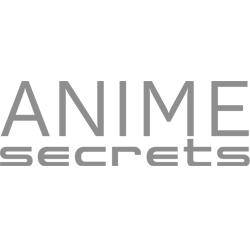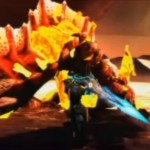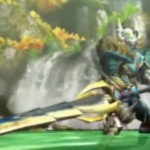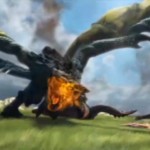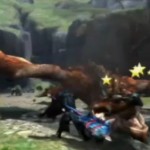Monster Hunter 3 Ultimate
Genre: Action-Adventure
Platform: Nintendo 3DS
Allegiance: Capcom
Vintage: 2013
Rating: T
Intelligence Agency Report by Skie:
Just as the new Hunter arrives in the picturesque Moga Village, a massive earthquake rocks the seaside community and he is tasked with investigating the cause of the quakes. The source is thought to be a Lagiacrus – a leviathan that has devastated the fishing fleet and is known for its aggressive behavior. However, the new Hunter is a bit of a greenhorn and needs to both earn his stripes and gain some gear before taking on the Lord of the Seas. Along with a rescued companion, the Hunter is tasked with everything from gathering resources for the rebuilding of the village to defending it from ferocious monsters in order to become strong enough to defeat the Lagiacrus… and even greater perils beyond.
Weapons Expert Report by Skie:
Plot: 6
Gameplay: 8
Visual: 9.5
Audio: 9.5
Impact: 8
Overall: 8.5
Monster Hunter 3 Ultimate (MH3U) is the next North American release of the hugely popular (In Japan, at least, but it’s got a North American fan base large enough to warrant another release) Monster Hunter franchise. It is a third-person action-adventure focused on the act of hunting monsters, as the title suggests. The 3DS version of MH3U builds upon the world and enemies established in Monster Hunter Tri for the Wii, giving new abilities to existing enemies and introducing entirely new monsters. There are even familiar faces for those who have been with the franchise for a long while hidden in the later parts of the game. Multiplayer is available as long as players are physically near each other, but it is not very easy to set up and requires fumbling through menus. Once figured out, though, playing with friends is just as fun and rewarding as always. It is too bad, however, that the 3DS does not support online play like the WiiU does.
The story is barebones at best. It is a straightforward premise with no twists and no real depth despite the flavor injected by the NPCs’ dialogue, but this is forgivable as one does not play Monster Hunter for its story. I’m actually rather glad the developers did not try to add more story as the game would feel much more confined if they did – as it stands, the story functions to answer the ‘why am I doing this’ question and that’s all that’s required of it.
The game mechanics of MH3U remain consistent with previous incarnations and have been relatively well adapted to the 3DS’s build. The Touch Screen provides a customizable hub – maps, inventory, monster icons, HP/Stamina Gauges and a variety of other accessory features can be arranged to the player’s pleasure. I found this to both clean up the game screen and split my attention unnecessarily, requiring some fiddling and getting used to the new layout. Beyond the interface, the actual mechanics of the game vary depending on which of the 12 weapon classes you prefer and which sets of armors with their accompanying bonuses you build. Each weapon class has multiple development trees featuring different elemental affinities, items slots, and balance between speed, mobility, blocking, and raw power. These allow you to create a vastly different fight when using the blazing fast dual swords instead of the heaving hitting hammers, for example. The desired results don’t change very much: you’re either poking a monster until it falls over dead or poking it until it’s mostly dead then tranquilizing it for capture. The choice of method affects the rewards you’re granted at the end of the quest. Additionally, quests have multiple fail conditions, such as fainting too many times or running out of time, which adds a sense of urgency to the more difficult quests and lends to more tactically-minded approaches. There’s nothing more frustrating than being two minutes away from finishing a great kill only to have the time run out and have to start over.
The monsters themselves are varied in their mechanics, speed, agility, and brute power and are more or less suited for the multiple environments offered in the game. Each class of monsters has a few shared themes, but each monster is uniquely individual in their encounter, keeping content fresh and avoiding predictability. Each monster has a repertoire of attacks and tells that the Hunter must learn not only to recognize but anticipate so that healing, sharpening of blades and gathering of bits you’ve chopped off the monster can be completed without getting punted across the map. The A.I.s are smart enough that multiple fights against the same creature are all different but balanced enough that learning the monster’s tactics can make for a very short fight. Tells like drooling, pausing to catch breath, frequent rages or limping all become exceptionally important when gauging the health of one’s opponent, as there are no health bars on the screen besides your own.
That said, the learning curve of the game has been sharply reduced as compared to previous games. This is a double edged sword – it makes the material more accessible to new players but makes the first sizeable portion of the game rather dull for experienced players. From a business point of view this makes sense when you want to welcome more people but it runs the risk of boring dedicated customers. The game opens with a series of gathering quests meant to immerse the player in game play via storytelling. Instructions provided are basic at best, however, as the variety of weapons forces the game to make a player learn through experimentation to avoid long and clunky explanations. There are, however, manuals built into the menus for reference and the game provides opportunity for experimentation via quiet areas or small monster encounters to get the player’s feet wet. After completion of the 5 Star Quest Level and associated Urgent quest where the game’s minimal plot wraps up, the difficulty ramps up swiftly and subspecies (read: recolours with modified and stronger attacks) are unlocked.
Finally, the underwater combat feature, while interesting and fresh, is entirely awkward. The direction the player-controlled camera is facing determines the direction the character will move, and the joystick controls the character’s forward and backward locomotion. It is a combination of these two factors that determine the direction of combat skills, but the actual movement of the character varies wildly, sometimes swimming or dashing off in a completely unintended direction despite this seemingly straightforward system. I found this incredibly frustrating as it made trying to launch attacks at an underwater foe or dodging a powerful attack almost feel like a gamble at times. My character could be facing the enemy and I would attempt a dodge only to have the hunter swim in an entirely wrong direction. The end game monster encounter even feels like the awkward camera control is a feature of the fight difficulty, and that is definitely a failure in the mechanics – poor controls should not be the source of difficulty in any encounter. MH3U suffers from this and it makes the aquatic quests very awkward to experience.
Visual Design and Sound are both gorgeous. The maps are huge with multiple areas featuring terrain that can be used for a variety of tactics – water to roll in when you’re on fire, tundra that saps your stamina, plains with rock towers to tempt a monster into charging – and are very aesthetically pleasing. The environments are rich and detailed with whole ecosystems built around the various landscape features. The monster models, too, are highly detailed with obvious thought spent towards colour and design to adapt them to their native environment. That said, the designs do get bizarre at times as the effort to blend multiple real-life animals into one monster don’t quite hit the ‘weird but cool’ mark and falls into the ‘what were they thinking?’ category. The models are beautifully rendered but the monster designs themselves can be awkward and not of the same caliber of the rest of the monster lineup. Last, but certainly not least – the armor and weapons. These, again, are well designed and there is a viewing option available for each piece before purchase. New armor becomes available to view upon obtaining some of the necessary components and each piece is beautiful, echoing the monster(s) they are crafted from in their design.
Sound is beautiful and present without being distracting, deepening the sensory immersion in the various environments. The icy tundra is made colder by the brittle echoes and crunch of snow while the volcano is made dark and imposing by the hisses of steam and burbling of lava. The combat music itself is useful and not just enjoyable to listen to – more than once, when I’d lost a monster, I would turn to the music to see if the boss fight song was playing in an area with blind spots.
Overall, this game is visually wonderfully executed but suffers from some rather awkward faults, such as the underwater camera controls. Its replay value is very nearly endless and if completion-oriented individuals get their hands on this game they will likely end up sinking days into the massive number of armor pieces and weapons that can be crafted. MH3U does not benefit from the 3D capability of the 3DS – I turned it off immediately as the amount of motion and movement within the game caused my eyes irritation unlike any other 3D game I’ve played on it before. The game does not lose anything without 3D and may actually gain some playability. The beautiful environments, attention to tactics, and combat balancing do much to overcome the problems and the game remains a wonderful experience. At the end of the day, the encounters are fun, if a bit easy, and there’s always a willingness to return for another round of play, which is what truly speaks to the game’s success.
